Jerry Cope and Charles Hambleton
August 4, 2010
The unprecedented disaster caused by the BP oil spill at the Deepwater Horizon Mississippi Canyon 252 site continues to expand even as National Incident Commander Thad Allen and BP assert that the situation is improving, the blown-out source capped and holding steady, the situation well in hand and cleanup operations are being scaled back. The New York Times declared on the front page this past week that the oil was disolving more rapidly than anticipated. Time magazine reported that environmental anti-advocate Rush Limbaugh had a point when he said the spill was a "leak". Thad Allen pointed out in a press conference that boats are still skimming on the surface, a futile gesture when the dispersant Corexit is being used to break down oil on the surface. As the oil is broken down, it mixes with the dispersant and flows under or over any booming operations.
To judge from most media coverage, the beaches are open, the fishing restrictions being lifted and the Gulf resorts open for business in a healthy, safe environment. We, along with Pierre LeBlanc, spent the last few weeks along the Gulf coast from Louisiana to Florida, and the reality is distinctly different. The coastal communities of Louisiana, Mississippi, Alabama, and Florida have been inundated by the oil and toxic dispersant Corexit 9500, and the entire region is contaminated. The once pristine white beaches that have been subject to intense cleaning operations now contain the oil/dispersant contamination to an unknown depth. The economic impacts potentially exceed even the devastation of a major hurricane like Katrina, the adverse impacts on health and welfare of human populations are increasing every minute of every day and the long-term effects are potentially life threatening.
Over the Gulf from the Source (official term for the Deepwater Horizon spill site) in to shore there is virtually no sign of life anywhere in the vast areas covered by the dispersed oil and Corexit. This in a region previously abundant with life above and below the ocean's surface in all its diversity. For months now, scientists and environmental organizations have been asking where all the animals are. The reported numbers of marine animals lost from BP fall far short of the observed loss. The water has a heavy appearance and the slightly iridescent greenish yellow color that extends as far as the eye can see.
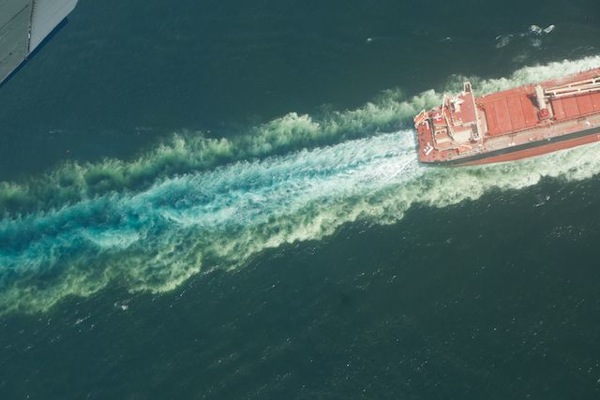
Wake of vessel near the Source through the toxic dispersant Corexit
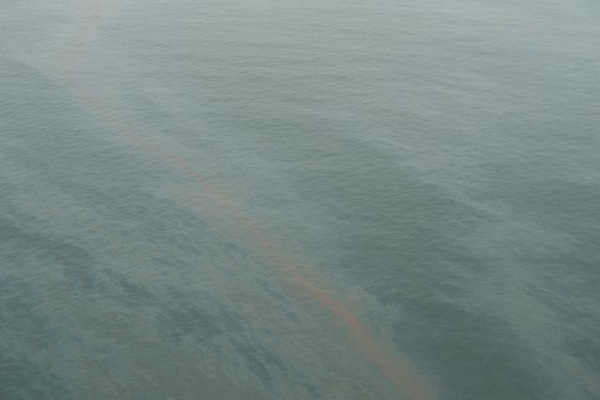
Corexit and a thin line of orangish crude dispersing on the surface
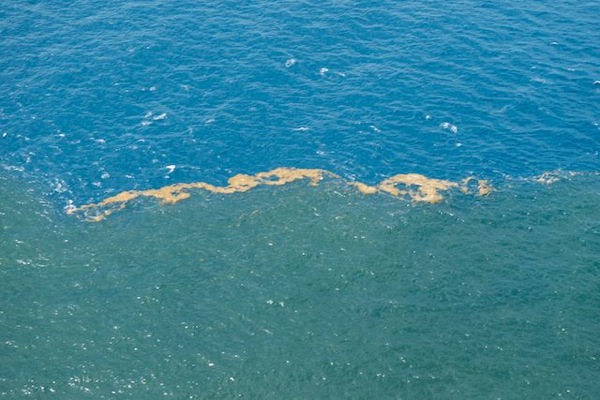
The ocean covered in Corexit is green, and a line of crude being dispersed
On two, unrestricted day-long flights, on July 22nd and 23rd, we were fortunate enough to be on with official clearance. We saw a total of four distressed dolphins and three schools of rays on the surface. As the bottom of the ocean is covered with crude and only the oil on the surface broken up by dispersant, the rays are forced up to the surface in a futile attempt to find food and oxygen. Birds are scarce where one would usually find thousands upon thousands. The Gulf of Mexico from the Source into the shore is a giant kill zone.
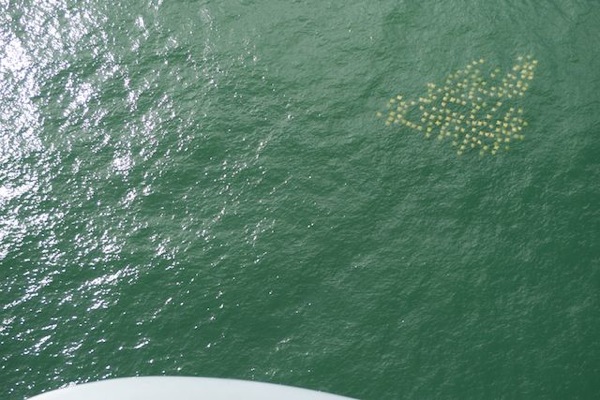
Rays near the Source
In May, Mother Nature Network blogger Karl Burkart received a tip from an anonymous fisherman-turned-BP contractor in the form of a distressed text message, describing a near-apocalyptic sight near the location of the sunken Deepwater Horizon -- fish, dolphins, rays, squid, whales, and thousands of birds -- "as far as the eye can see," dead and dying. According to his statement, which was later confirmed by another report from an individual working in the Gulf, whale carcasses were being shipped to a highly guarded location where they were processed for disposal.
CitizenGlobal Gulf News Desk received photos that matched the report and are being published on Karl's blog today. Local fisherman in Alabama report sighting tremendous numbers of dolphins, sharks, and fish moving in towards shore as the initial waves of oil and dispersant approached in June. Many third- and fourth-generation fisherman declared emphatically that they had never seen or heard of any similar event in the past. Scores of animals were fleeing the leading edge of toxic dispersant mixed with oil. Those not either caught in the toxic mixture and killed out at sea, or fortunate enough to be out in safe water beyond the Source, died as the water closed in, and they were left no safe harbor. The numbers of birds, fish, turtles, and mammals killed by the use of Corexit will never be known as the evidence strongly suggests that BP worked with the Coast Guard, the Department of Homeland Security, the FAA, private security contractors, and local law enforcement, all of which cooperated to conceal the operations disposing of the animals from the media and the public.
The majority of the disposal operations were carried out under cover of darkness. The areas along the beaches and coastal Islands where the dead animals were collected were closed off by the U.S. Coast Guard. On shore, private contractors and local law enforcement officials kept off limits the areas where the remains of the dead animals were dumped, mainly at the Magnolia Springs landfill by Waste Management where armed guards controlled access. The nearby weigh station where the Waste Management trucks passed through with their cargoes was also restricted by at least one Sheriff's deputies in a patrol car, 24/7.
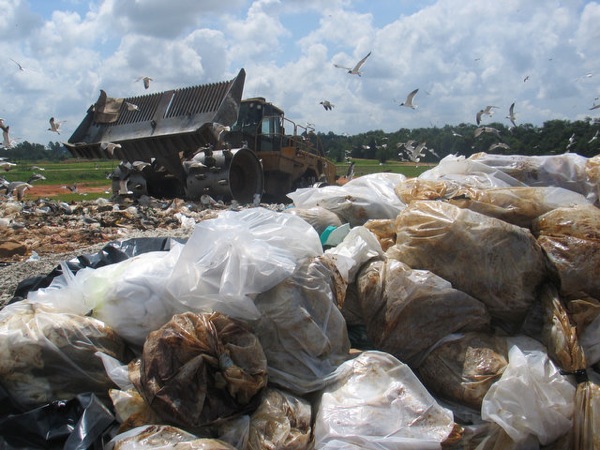
Magnolia landfill during initial cleanup, courtesy of Press-Register, Connie Baggett
Robyn Hill, who was Beach Ambassador for the City of Gulf Shores until she became so ill she collapsed on the job one morning, was at a residential condominium property adjacent to the Gulf Shores beach when she smelled an overwhelming stench. She went to see where the odor was coming from and witnessed two contract workers dumping plastic bags full of dead birds and fish in a residential Waste Management dumpster, which was then protected by a security guard. Within five minutes, a Waste Management collection truck emptied the contents and the guard departed.
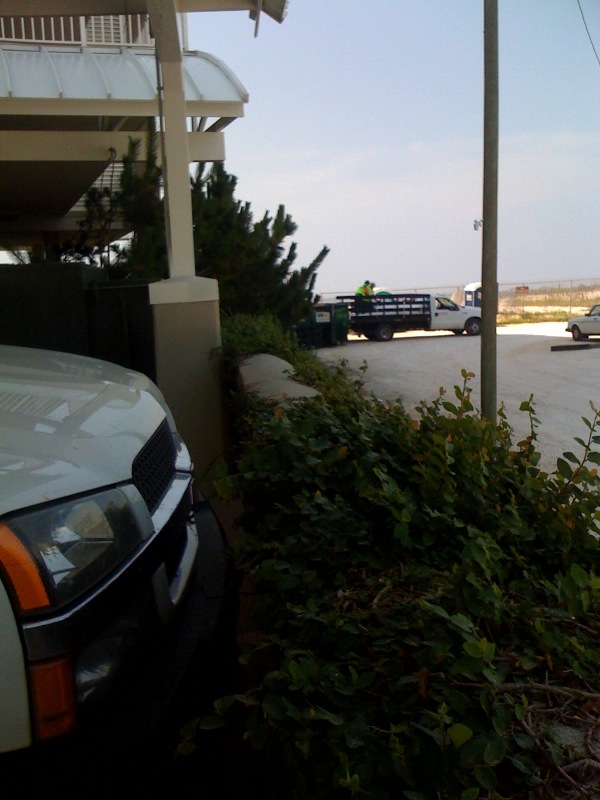
Photo by Robyn Hill
The oceans are empty, the skies tinged yellow by evaporating oil and toxic dispersant devoid of birds, dogs mysteriously have no fleas, and in an area usually besieged by mosquitoes, there is little need for repellent, and the usual trucks spraying are nowhere to be seen.
Dauphin Island was one of the sites where carcasses of sperm whales were destroyed. The operational end of the island was closed to unauthorized personnel and the airspace closed. The U.S. Coast Guard closed off all access from the Gulf. This picture shows the area as it was prepped to receive the whale carcasses for disposal.
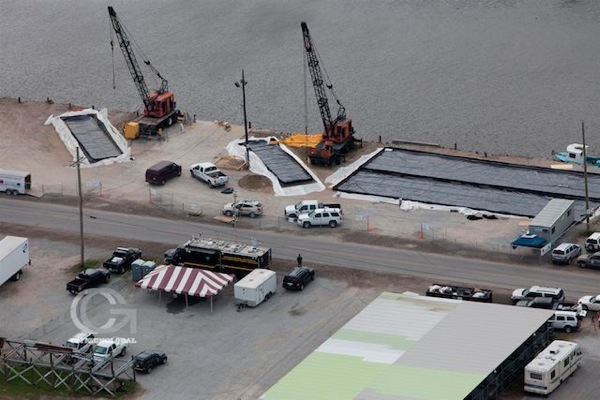
Riki Ott, PhD, has been in the region for the past three months. A veteran of the Exxon Valdez spill and renowned marine toxicologist, Ott has documented numerous accounts of the devastating results from BP and the government's use of Corexit in the gulf. We spoke at length last week:
JC: There has been a great deal of discussion about the disappearance of the animals and the life in the ocean which seem to have vanished since this incident has occurred. What do you know about this?RO: Well I have been down in the Gulf since May 3rd. It's pretty consistent what I have heard. First I heard from the offshore workers and the boat captains that were coming in and they would see windrows of dead things piled up on the barrier islands; turtles and birds and dolphins... whales...
WATCH Jerry's interview with Ott:
Full story HERE
No comments:
Post a Comment